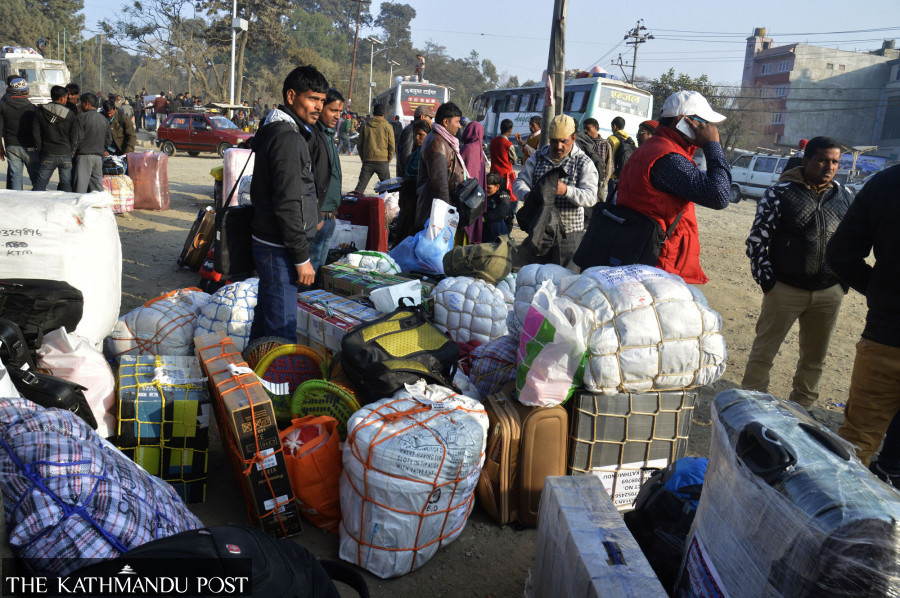Money
Social and economic reintegration programmes for returnee migrant workers set to begin
Foreign Employment Board has approved proposals from 81 local units to start the programmes.
Pawan Pandey
Around nine months after bringing a directive for carrying out social and economic reintegration programmes for the returnee migrant workers and only three months remaining in the current fiscal year 2022-23, the Foreign Employment Board has approved proposals from 81 local levels to start the programmes.
The government brought out the Reintegration Programme (Operation and Management) Directives for Returning Migrant Workers 2022 in mid-July last year.
The board has set aside Rs150 million from the Foreign Employment Welfare Fund for the reintegration programmes in the current fiscal year, according to Rama Bhattarai, director at the Foreign Employment Board.
“The programmes for 3,220 beneficiaries, setting aside Rs43,000 for each of them, have been approved,” Bhattarai told the Post. “While Rs35,000 will be provided as financial assistance through the respective local level, Rs8,000 would be spent on training.”
“A local level which performs well will be provided an additional amount of as much as Rs500,000 from the remaining budget,” Bhattarai added.
The accumulated amount at the Foreign Employment Welfare Fund is around Rs5.35 billion, according to Rajan Paudel, information officer at the board.
The fund is managed by the board and is used to provide various welfare and social protection services such as financial assistance in the event of death and/or injury of migrant workers as well as scholarships to the children of the deceased.
Every migrant worker has to deposit Rs1,500 or Rs2,500 at the fund, depending on the duration of his labour approval.
Beside the government agency, provincial government or local level, the directives allow countries with bilateral agreements or diplomatic relations with Nepal or any national and international non-governmental organisations to conduct the reintegration programmes.
As part of the programme, the returnees will be provided with jobs or entrepreneurial opportunities depending on their skills and interests they have acquired abroad. They will also be given psychosocial counselling.
The board had sought proposals from 156 local levels which have implemented the Safer Migration (SaMi) Programme. “As many as 85 local levels had sent the proposals, demanding Rs430 million for the reintegration programmes, targeting around 24,000 beneficiaries,” said Bhattarai. “We selected 81 proposals.”
While the agreements have already been signed with 21 local levels from Bagmati, 16 from Madhes, 14 from Gandaki and 13 from Koshi to implement the programmes, the agreements with 17 local levels from Lumbini and Sudurpaschim provinces would be signed within a week, Bhattarai added. “We did not receive any proposal from local levels in Karnali Province.”
Some local levels have also made a commitment to provide additional financial assistance, besides the one from the board.
“We have started sending the funds to the local level,” said Bhattari. “They will make their own guidelines to implement the programme."
The Belkotgadhi Municipality in Nuwakot is one of the local levels implementing the reintegration programmes. It has decided to provide the beneficiaries with an additional 10 percent in financial assistance.
The municipality plans to utilise the amount to help returnees run homestays, buy equipment for farming and start a new business as well as to address the mental health-related issues among them, according to Hari Gajurel, employment coordinator at the Employment Service Centre of the municipality.
The employment coordinator is one of the members of the reintegration programme implementation committee at the respective local level.
Though the municipality had sent the proposal to the board demanding around Rs8 million and targeting around 300 beneficiaries, it is set to receive the fund for assisting 60 returnees.
To prevent the misuse of funds, the municipality has planned to prioritise workers who would also have at least 25 percent of their own investment besides the financial assistance from the board to carry out their proposed financial activities.
“We will ask the workers to present the cost estimates for their proposed financial activities,” said Gajurel.
The labour migration researchers, however, doubt the effectiveness of the programmes, citing issues related to the intended returnees and budget. The programmes, in the meantime, should be carried out as a pilot to learn the issues in detail for making further improvements, they said.
Jeevan Baniya, assistant director at the Centre for Study of Labour and Mobility, Social Science Baha, a research institution, said the very definition of integration needs to be made clear in the first place.
“We are intending to reintegrate returnees at a certain place without considering if the skills they possess match with the market demand in that place,” said Baniya. “Instead of such a static approach, the authorities need to invest in skilling and reskilling returnees to make them able to work anywhere across the country, or even abroad, as step migration and circular migration are today’s realities.”
“The identification and prioritisation of the beneficiaries is key to the effectiveness of the programme,” said Baniya. “Along with the workers who return home after unpleasant labour experiences and without any financial capital, the families of the injured, ill as well as dead migrant workers too need to be prioritised in the reintegration efforts.”
Though external remittances have become a lifeline for the country’s economy, the migrants who spent their youth abroad and sent money back to the country have to struggle to reintegrate financially and socially, when they return.
In the last fiscal year, Nepal received Rs1 trillion in remittances. The figure has already reached Rs794.32 billion in the first eight months of the current fiscal year.
The positive contributions of remittance have, however, overshadowed the social costs of labour migration.
The migrant departures have turned into an exodus amid a lack of decent opportunities at home.
In the past three fiscal years, even as the Covid-19 pandemic strangled the economy and rendered tens of thousands of people jobless, more than 1 million Nepalis left the country to find work in faraway lands.
The number of Nepalis getting labour permits, including the renewed entry, has already reached around 544,ooo in the first eight months of the current fiscal year which ends mid-July 2023, excluding the labour migrations to India.
The issue of returnee migrant workers and their reintegration, however, started receiving attention because of the reverse migration trend seen during the pandemic.
Nearly 204,000 migrant workers in the fiscal year 2020-21 and around 471,000 in 2021-22 returned home through the Tribhuvan International Airport, according to the Nepal Labour Migration Report 2022.
While Bhattarai from the Foreign Employment Board said the programmes’ implementation and effectiveness would be evaluated to bring changes to them for expanding them further in the coming fiscal year, Baniya, the labour migration expert, argued a holistic approach through coordination among the public and private sector in the federal, provincial and local level for creating jobs and entrepreneurship opportunities was the need of the hour.




 12.99°C Kathmandu
12.99°C Kathmandu













%20(1).jpg&w=300&height=200)
